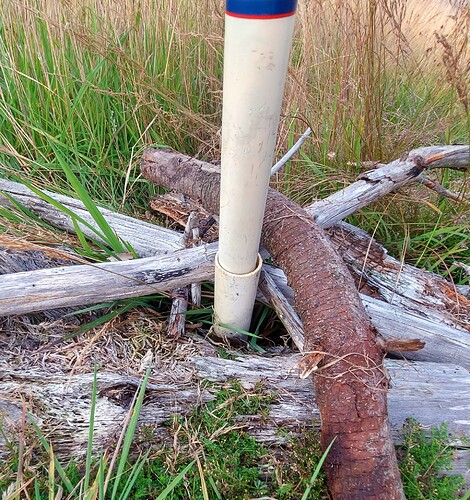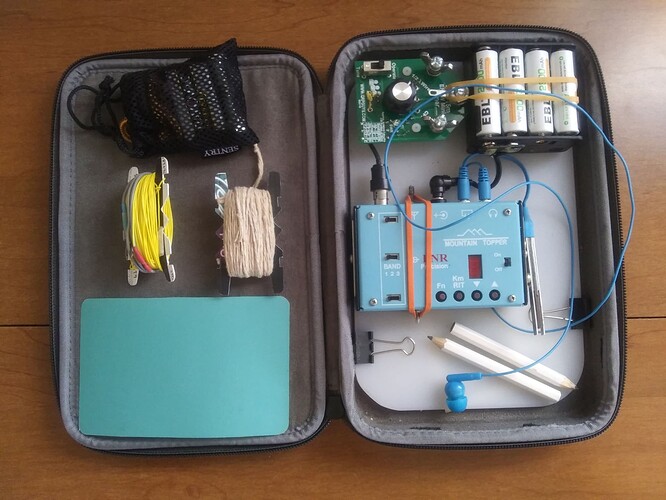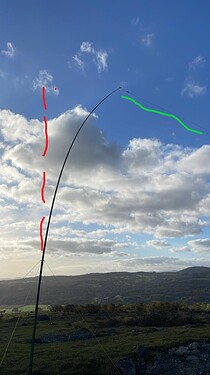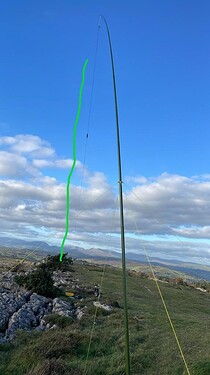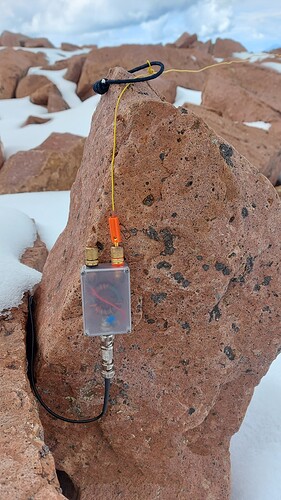You didn’t say what configuration you intend to use for your EF (halfwave?) antenna: horizontal, inverted V, sloper, etc.
I rule out horizontal and inverted L for quick and practical portable use. I activate solo and carry one 6m-long telescoping fibreglass pole, not two poles. I very rarely find anything on SOTA summits (like a tree at the right distance and with suitable branches) to attach the other end of the wire to the same height.
I find it takes longer to put up an inverted V (than a sloper) especially in strong wind where the two wire halves want to get entangled. I use inverted V config only for my linked dipoles.
So, that leaves the sloper configuration. I always first choose where I want to sit (in a sheltered spot out of the wind if possible – which maximizes my activation time).
If I’m lucky there’s a stonewall, fence, bush etc at my chosen operating spot to which I can attach the Z-match transformer end 1 or 2m off the ground. If not, I have a 2m cord to extend the wire to a ground peg so the Z-box is off the ground 50cm or so. I use a 2m RG58 coax to run from the Z-box to my rig (KX2 with internal ATU).
Bungee cord (green) to bush, EFHW wire (red), 2m coax to rig (blue), Z-match box (yellow)
I pay out the antenna wire on the ground from the winder and assemble the 6m pole with O-ring and guy cords (I use 4 not 3), then attach the end of the EFHW to the top end of the 6m pole with a few cm’s of bungee cord.
If it’s not windy (like on yesterday’s activation) I raise the pole and move it until the EFHW is taut and attach the guy cord on the opposite side of the antenna wire to a ground peg. At this point, the pole can only fall over at 90 degrees to the line of the antenna, so I put in a guy & peg on one ‘side’. With two guys attached I can usually let go of the pole and then do the other two guys/pegs. The guying usually needs some readjustment especially on rocky summits where the soil is thin.
The thin sections at the top of the mast should be bending over due to the tension in the wire, otherwise you will have a big sag in the wire which will detune the antenna (as its effective length is too short).
If it’s very windy I determine where the pole needs to be (as above) but lay the pole down and attach the (four) guy cords to the pegs and then raise the pole. You need to know how far away from the base of the pole the pegs need to be. Practice this somewhere benign like your garden lawn or local park to get the distance right.
Other activators will tell you to do the pole bit first and pay out the antenna wire to wherever the wire ends (and activate at that spot). But they are young (and impervious to the cold and rain) or activate in warm weather or on wooded hilltops.

